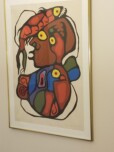Around the same time I bought the Pachter print Noblesse Oblige – the mid-Seventies – through through the agency of my parents’ art store I bought a Morrisseau print entitled Power with Unity, one of a limited edition of 89.
Up the Wall
First a word about my parents’ store. It was called Up the Wall and located in Toronto at the foot of Jarvis Street, near Front. Their theme was to sell art to put up on your walls; in the Seventies, when they began, weavings and wall-hangings were as popular as paintings, especially for people on a budget. For stock, they reached out to importers and to the local arts community, which put them in touch with Morrisseau’s work. Over time, they began to focus on Inuit art, but that’s another story.
Power with Unity
Much has been written about Norval Morrisseau (1934 – 2007), as the pre-eminent indigenous painter of his generation, and inspiration to another generation of indigenous painters, often referred to as the Woodland School. Carmen Robertson’s discussion on the Art Canada Institute website is a valuable reference. Power with Unity has the well-known characteristics of his work: bright colours; black “power lines” connecting figures who stand in relationships with one another; and integration of people, animals, and the environment.
Power with Unity has four figures: a fish at the top, a human in the middle, a turtle at the bottom with its head reaching up just to the right of the human’s head, and a bird at the bottom. Each one has a bright yellow eye, in profile. The figures are not in conflict, as the viewer can see each one of them, without the sense that any one is pushing any other one aside. In their totality, the figures form a circular shape, which is accentuated by the circular power lines around them all. For Morrisseau, power emerges from the unity of humanity with the animal species around us. The turtle may also symbolize the physical environment around us, as in the term Turtle Island, which is well understood now but wasn’t then. This represents unity among humanity, animal species, and the environment.
We chose to hang the Pachter and Morrisseau prints at right angles to one another on the landing between the first and second floors, as shown in my photo. Maybe we did that simply because they are the same size and have strong colours.
In thinking about it, the relationship between the paintings is deeper than that. Both are Canadian artists who made these prints at approximately the same time. Both were then outsiders in the Canadian art world, Morrisseau Anishnaabe, Pachter Jewish.
But there is an important difference between their themes. Pachter is portraying and interrogating the dominance of a thin slice of humanity – the British monarchy – over the land of Canada, represented by the moose. Not only is the monarch, as a specific person, of cultural significance, but the language of monarchy has made Crown synonymous with government or state, as we refer to Crown attorneys, Crown lands, Crown agencies, Crown corporations.
Morrisseau is rejecting human dominance, whether by the British monarchy or Canadian settlers, and setting out a vision of cooperation between humanity, the animal world, and the environment. This is a vision that has become both harder, and more essential, to realize in the Anthropocene age.
The One I Missed
A decade after I bought Power with Unity, I had my eye – in both senses – on a much larger Morrisseau work, his masterful six-canvas autobiographical series of paintings entitled Man Changing into Thunderbird. (As a result of a near-miraculous recovery from illness as a young man, Morrisseau was given the Anishnaabe name Copper Thunderbird). The paintings, each 60 by 48 inches, were on sale for several years in the mid-Eighties at Whetung Gallery on the Curve Lake Reserve, not far from our cottage near Peterborough. The gallery was asking $4000 ($10,000 in today’s money), which struck me as reasonable given the size and significance of the work.
I seriously considered buying the paintings. I was single and had the cash. Unfortunately, I was living in a reasonably small house and didn’t have the wall space – at least in one room. Ultimately someone else bought it.
The paintings now hang in the Art Gallery of Ontario and are also shown on its website. They are on loan from a private donor. I hope that at some point they will make the temporary loan a permanent bequest. These paintings are so important a part of our national heritage that they must be visible at a major public institution. I hope that if I had purchased Man Changing into Thunderbird, I would have considered my relationship with it as one of stewardship rather than ownership and ensured it made its way into the public domain.



Leave a Reply